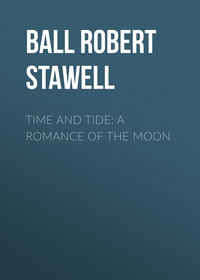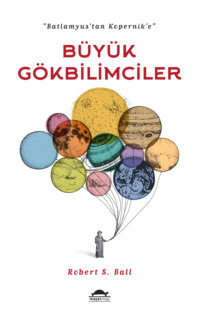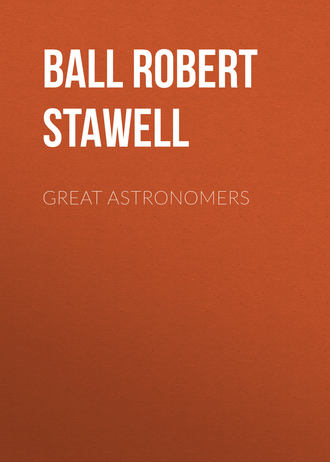 полная версия
полная версияGreat Astronomers
Copernicus shows clearly how the observed phenomena could be accounted for just as completely by a rotation of the earth as by a rotation of the heavens. He alludes to the fact that, to those on board a vessel which is moving through smooth water, the vessel itself appears to be at rest, while the objects on shore seem to be moving past. If, therefore, the earth were rotating uniformly, we dwellers upon the earth, oblivious of our own movement, would wrongly attribute to the stars the displacement which was actually the consequence of our own motion.
Copernicus saw the futility of the arguments by which Ptolemy had endeavoured to demonstrate that a revolution of the earth was impossible. It was plain to him that there was nothing whatever to warrant refusal to believe in the rotation of the earth. In his clear-sightedness on this matter we have specially to admire the sagacity of Copernicus as a natural philosopher. It had been urged that, if the earth moved round, its motion would not be imparted to the air, and that therefore the earth would be uninhabitable by the terrific winds which would be the result of our being carried through the air. Copernicus convinced himself that this deduction was preposterous. He proved that the air must accompany the earth, just as his coat remains round him, notwithstanding the fact that he is walking down the street. In this way he was able to show that all a priori objections to the earth's movements were absurd, and therefore he was able to compare together the plausibilities of the two rival schemes for explaining the diurnal movement.

FRAUENBURG, FROM AN OLD PRINT.
Once the issue had been placed in this form, the result could not be long in doubt. Here is the question: Which is it more likely—that the earth, like a grain of sand at the centre of a mighty globe, should turn round once in twenty-four hours, or that the whole of that vast globe should complete a rotation in the opposite direction in the same time? Obviously, the former is far the more simple supposition. But the case is really much stronger than this. Ptolemy had supposed that all the stars were attached to the surface of a sphere. He had no ground whatever for this supposition, except that otherwise it would have been well-nigh impossible to have devised a scheme by which the rotation of the heavens around a fixed earth could have been arranged. Copernicus, however, with the just instinct of a philosopher, considered that the celestial sphere, however convenient from a geometrical point of view, as a means of representing apparent phenomena, could not actually have a material existence. In the first place, the existence of a material celestial sphere would require that all the myriad stars should be at exactly the same distances from the earth. Of course, no one will say that this or any other arbitrary disposition of the stars is actually impossible, but as there was no conceivable physical reason why the distances of all the stars from the earth should be identical, it seemed in the very highest degree improbable that the stars should be so placed.
Doubtless, also, Copernicus felt a considerable difficulty as to the nature of the materials from which Ptolemy's wonderful sphere was to be constructed. Nor could a philosopher of his penetration have failed to observe that, unless that sphere were infinitely large, there must have been space outside it, a consideration which would open up other difficult questions. Whether infinite or not, it was obvious that the celestial sphere must have a diameter at least many thousands of times as great as that of the earth. From these considerations Copernicus deduced the important fact that the stars and the other celestial bodies must all be vast objects. He was thus enabled to put the question in such a form that it could hardly receive any answer but the correct one. Which is it more rational to suppose, that the earth should turn round on its axis once in twenty-four hours, or that thousands of mighty stars should circle round the earth in the same time, many of them having to describe circles many thousands of times greater in circumference than the circuit of the earth at the equator? The obvious answer pressed upon Copernicus with so much force that he was compelled to reject Ptolemy's theory of the stationary earth, and to attribute the diurnal rotation of the heavens to the revolution of the earth on its axis.
Once this tremendous step had been taken, the great difficulties which beset the monstrous conception of the celestial sphere vanished, for the stars need no longer be regarded as situated at equal distances from the earth. Copernicus saw that they might lie at the most varied degrees of remoteness, some being hundreds or thousands of times farther away than others. The complicated structure of the celestial sphere as a material object disappeared altogether; it remained only as a geometrical conception, whereon we find it convenient to indicate the places of the stars. Once the Copernican doctrine had been fully set forth, it was impossible for anyone, who had both the inclination and the capacity to understand it, to withhold acceptance of its truth. The doctrine of a stationary earth had gone for ever.
Copernicus having established a theory of the celestial movements which deliberately set aside the stability of the earth, it seemed natural that he should inquire whether the doctrine of a moving earth might not remove the difficulties presented in other celestial phenomena. It had been universally admitted that the earth lay unsupported in space. Copernicus had further shown that it possessed a movement of rotation. Its want of stability being thus recognised, it seemed reasonable to suppose that the earth might also have some other kinds of movements as well. In this, Copernicus essayed to solve a problem far more difficult than that which had hitherto occupied his attention. It was a comparatively easy task to show how the diurnal rising and setting could be accounted for by the rotation of the earth. It was a much more difficult undertaking to demonstrate that the planetary movements, which Ptolemy had represented with so much success, could be completely explained by the supposition that each of those planets revolved uniformly round the sun, and that the earth was also a planet, accomplishing a complete circuit of the sun once in the course of a year.

EXPLANATION OF PLANETARY MOVEMENTS.
It would be impossible in a sketch like the present to enter into any detail as to the geometrical propositions on which this beautiful investigation of Copernicus depended. We can only mention a few of the leading principles. It may be laid down in general that, if an observer is in movement, he will, if unconscious of the fact, attribute to the fixed objects around him a movement equal and opposite to that which he actually possesses. A passenger on a canal-boat sees the objects on the banks apparently moving backward with a speed equal to that by which he is himself advancing forwards. By an application of this principle, we can account for all the phenomena of the movements of the planets, which Ptolemy had so ingeniously represented by his circles. Let us take, for instance, the most characteristic feature in the irregularities of the outer planets. We have already remarked that Mars, though generally advancing from west to east among the stars, occasionally pauses, retraces his steps for awhile, again pauses, and then resumes his ordinary onward progress. Copernicus showed clearly how this effect was produced by the real motion of the earth, combined with the real motion of Mars. In the adjoining figure we represent a portion of the circular tracks in which the earth and Mars move in accordance with the Copernican doctrine. I show particularly the case where the earth comes directly between the planet and the sun, because it is on such occasions that the retrograde movement (for so this backward movement of Mars is termed) is at its highest. Mars is then advancing in the direction shown by the arrow-head, and the earth is also advancing in the same direction. We, on the earth, however, being unconscious of our own motion, attribute, by the principle I have already explained, an equal and opposite motion to Mars. The visible effect upon the planet is, that Mars has two movements, a real onward movement in one direction, and an apparent movement in the opposite direction. If it so happened that the earth was moving with the same speed as Mars, then the apparent movement would exactly neutralise the real movement, and Mars would seem to be at rest relatively to the surrounding stars. Under the actual circumstances represented, however, the earth is moving faster than Mars, and the consequence is, that the apparent movement of the planet backwards exceeds the real movement forwards, the net result being an apparent retrograde movement.
With consummate skill, Copernicus showed how the applications of the same principles could account for the characteristic movements of the planets. His reasoning in due time bore down all opposition. The supreme importance of the earth in the system vanished. It had now merely to take rank as one of the planets.
The same great astronomer now, for the first time, rendered something like a rational account of the changes of the seasons. Nor did certain of the more obscure astronomical phenomena escape his attention.
He delayed publishing his wonderful discoveries to the world until he was quite an old man. He had a well-founded apprehension of the storm of opposition which they would arouse. However, he yielded at last to the entreaties of his friends, and his book was sent to the press. But ere it made its appearance to the world, Copernicus was seized by mortal illness. A copy of the book was brought to him on May 23, 1543. We are told that he was able to see it and to touch it, but no more, and he died a few hours afterwards. He was buried in that Cathedral of Frauenburg, with which his life had been so closely associated.
TYCHO BRAHE
The most picturesque figure in the history of astronomy is undoubtedly that of the famous old Danish astronomer whose name stands at the head of this chapter. Tycho Brahe was alike notable for his astronomical genius and for the extraordinary vehemence of a character which was by no means perfect. His romantic career as a philosopher, and his taste for splendour as a Danish noble, his ardent friendships and his furious quarrels, make him an ideal subject for a biographer, while the magnificent astronomical work which he accomplished, has given him imperishable fame.
The history of Tycho Brahe has been admirably told by Dr. Dreyer, the accomplished astronomer who now directs the observatory at Armagh, though himself a countryman of Tycho. Every student of the career of the great Dane must necessarily look on Dr. Dreyer's work as the chief authority on the subject. Tycho sprang from an illustrious stock. His family had flourished for centuries, both in Sweden and in Denmark, where his descendants are to be met with at the present day. The astronomer's father was a privy councillor, and having filled important positions in the Danish government, he was ultimately promoted to be governor of Helsingborg Castle, where he spent the last years of his life. His illustrious son Tycho was born in 1546, and was the second child and eldest boy in a family of ten.
It appears that Otto, the father of Tycho, had a brother named George, who was childless. George, however, desired to adopt a boy on whom he could lavish his affection and to whom he could bequeath his wealth. A somewhat singular arrangement was accordingly entered into by the brothers at the time when Otto was married. It was agreed that the first son who might be born to Otto should be forthwith handed over by the parents to George to be reared and adopted by him. In due time little Tycho appeared, and was immediately claimed by George in pursuance of the compact. But it was not unnatural that the parental instinct, which had been dormant when the agreement was made, should here interpose. Tycho's father and mother receded from the bargain, and refused to part with their son. George thought he was badly treated. However, he took no violent steps until a year later, when a brother was born to Tycho. The uncle then felt no scruple in asserting what he believed to be his rights by the simple process of stealing the first-born nephew, which the original bargain had promised him. After a little time it would seem that the parents acquiesced in the loss, and thus it was in Uncle George's home that the future astronomer passed his childhood.
When we read that Tycho was no more than thirteen years old at the time he entered the University of Copenhagen, it might be at first supposed that even in his boyish years he must have exhibited some of those remarkable talents with which he was afterwards to astonish the world. Such an inference should not, however, be drawn. The fact is that in those days it was customary for students to enter the universities at a much earlier age than is now the case. Not, indeed, that the boys of thirteen knew more then than the boys of thirteen know now. But the education imparted in the universities at that time was of a much more rudimentary kind than that which we understand by university education at present. In illustration of this Dr. Dreyer tells us how, in the University of Wittenberg, one of the professors, in his opening address, was accustomed to point out that even the processes of multiplication and division in arithmetic might be learned by any student who possessed the necessary diligence.
It was the wish and the intention of his uncle that Tycho's education should be specially directed to those branches of rhetoric and philosophy which were then supposed to be a necessary preparation for the career of a statesman. Tycho, however, speedily made it plain to his teachers that though he was an ardent student, yet the things which interested him were the movements of the heavenly bodies and not the subtleties of metaphysics.

TYCHO BRAHE.
On the 21st October, 1560, an eclipse of the sun occurred, which was partially visible at Copenhagen. Tycho, boy though he was, took the utmost interest in this event. His ardour and astonishment in connection with the circumstance were chiefly excited by the fact that the time of the occurrence of the phenomenon could be predicted with so much accuracy. Urged by his desire to understand the matter thoroughly, Tycho sought to procure some book which might explain what he so greatly wanted to know. In those days books of any kind were but few and scarce, and scientific books were especially unattainable. It so happened, however, that a Latin version of Ptolemy's astronomical works had appeared a few years before the eclipse took place, and Tycho managed to buy a copy of this book, which was then the chief authority on celestial matters. Young as the boy astronomer was, he studied hard, although perhaps not always successfully, to understand Ptolemy, and to this day his copy of the great work, copiously annotated and marked by the schoolboy hand, is preserved as one of the chief treasures in the library of the University at Prague.
After Tycho had studied for about three years at the University of Copenhagen, his uncle thought it would be better to send him, as was usual in those days, to complete his education by a course of study in some foreign university. The uncle cherished the hope that in this way the attention of the young astronomer might be withdrawn from the study of the stars and directed in what appeared to him a more useful way. Indeed, to the wise heads of those days, the pursuit of natural science seemed so much waste of good time which might otherwise be devoted to logic or rhetoric or some other branch of study more in vogue at that time. To assist in this attempt to wean Tycho from his scientific tastes, his uncle chose as a tutor to accompany him an intelligent and upright young man named Vedel, who was four years senior to his pupil, and accordingly, in 1562, we find the pair taking up their abode at the University of Leipzig.
The tutor, however, soon found that he had undertaken a most hopeless task. He could not succeed in imbuing Tycho with the slightest taste for the study of the law or the other branches of knowledge which were then thought so desirable. The stars, and nothing but the stars, engrossed the attention of his pupil. We are told that all the money he could obtain was spent secretly in buying astronomical books and instruments. He learned the name of the stars from a little globe, which he kept hidden from Vedel, and only ventured to use during the latter's absence. No little friction was at first caused by all this, but in after years a fast and enduring friendship grew up between Tycho and his tutor, each of whom learned to respect and to love the other.
Before Tycho was seventeen he had commenced the difficult task of calculating the movements of the planets and the places which they occupied on the sky from time to time. He was not a little surprised to find that the actual positions of the planets differed very widely from those which were assigned to them by calculations from the best existing works of astronomers. With the insight of genius he saw that the only true method of investigating the movements of the heavenly bodies would be to carry on a protracted series of measurements of their places. This, which now seems to us so obvious, was then entirely new doctrine. Tycho at once commenced regular observations in such fashion as he could. His first instrument was, indeed, a very primitive one, consisting of a simple pair of compasses, which he used in this way. He placed his eye at the hinge, and then opened the legs of the compass so that one leg pointed to one star and the other leg to the other star. The compass was then brought down to a divided circle, by which means the number of degrees in the apparent angular distance of the two stars was determined.
His next advance in instrumental equipment was to provide himself with the contrivance known as the "cross-staff," which he used to observe the stars whenever opportunity offered. It must, of course, be remembered that in those days there were no telescopes. In the absence of optical aid, such as lenses afford the modern observers, astronomers had to rely on mechanical appliances alone to measure the places of the stars. Of such appliances, perhaps the most ingenious was one known before Tycho's time, which we have represented in the adjoining figure.

Let us suppose that it be desired to measure the angle between two stars, then if the angle be not too large it can be determined in the following manner. Let the rod AB be divided into inches and parts of an inch, and let another rod, CD, slide up and down along AB in such a way that the two always remain perpendicular to each other. "Sights," like those on a rifle, are placed at A and C, and there is a pin at D. It will easily be seen that, by sliding the movable bar along the fixed one, it must always be possible when the stars are not too far apart to bring the sights into such positions that one star can be seen along DC and the other along DA. This having been accomplished, the length from A to the cross-bar is read off on the scale, and then, by means of a table previously prepared, the value of the required angular distance is obtained. If the angle between the two stars were greater than it would be possible to measure in the way already described, then there was a provision by which the pin at D might be moved along CD into some other position, so as to bring the angular distance of the stars within the range of the instrument.

TYCHO'S "NEW STAR" SEXTANT OF 1572.
(The arms, of walnut wood, are about 5 1/2 ft. long.)
No doubt the cross-staff is a very primitive contrivance, but when handled by one so skilful as Tycho it afforded results of considerable accuracy. I would recommend any reader who may have a taste for such pursuits to construct a cross-staff for himself, and see what measurements he can accomplish with its aid.
To employ this little instrument Tycho had to evade the vigilance of his conscientious tutor, who felt it his duty to interdict all such occupations as being a frivolous waste of time. It was when Vedel was asleep that Tycho managed to escape with his cross staff and measure the places of the heavenly bodies. Even at this early age Tycho used to conduct his observations on those thoroughly sound principles which lie at the foundation of all accurate modern astronomy. Recognising the inevitable errors of workmanship in his little instrument, he ascertained their amount and allowed for their influence on the results which he deduced. This principle, employed by the boy with his cross-staff in 1564, is employed at the present day by the Astronomer Royal at Greenwich with the most superb instruments that the skill of modern opticians has been able to construct.
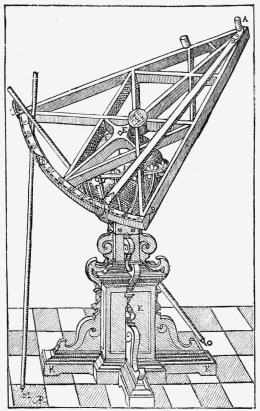
TYCHO'S TRIGONIC SEXTANT.
(The arms, AB and AC, are about 5 1/2 ft. long.)
After the death of his uncle, when Tycho was nineteen years of age, it appears that the young philosopher was no longer interfered with in so far as the line which his studies were to take was concerned. Always of a somewhat restless temperament, we now find that he shifted his abode to the University of Rostock, where he speedily made himself notable in connection with an eclipse of the moon on 28th October, 1566. Like every other astronomer of those days, Tycho had always associated astronomy with astrology. He considered that the phenomena of the heavenly bodies always had some significance in connection with human affairs. Tycho was also a poet, and in the united capacity of poet, astrologer, and astronomer, he posted up some verses in the college at Rostock announcing that the lunar eclipse was a prognostication of the death of the great Turkish Sultan, whose mighty deeds at that time filled men's minds. Presently news did arrive of the death of the Sultan, and Tycho was accordingly triumphant; but a little later it appeared that the decease had taken place BEFORE the eclipse, a circumstance which caused many a laugh at Tycho's expense.
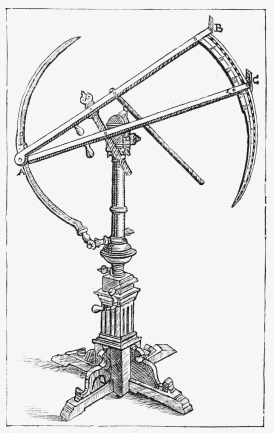
TYCHO'S ASTRONOMIC SEXTANT.
(Made of steel; the arms, A B, A C, measure 4ft.)
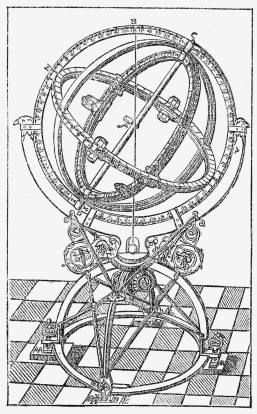
TYCHO'S EQUATORIAL ARMILLARY.
(The meridian circle, E B C A D, made of solid steel, is nearly 6 ft. in diameter.)
Tycho being of a somewhat turbulent disposition, it appears that, while at the University of Rostock, he had a serious quarrel with another Danish nobleman. We are not told for certain what was the cause of the dispute. It does not, however, seem to have had any more romantic origin than a difference of opinion as to which of them knew the more mathematics. They fought, as perhaps it was becoming for two astronomers to fight, under the canopy of heaven in utter darkness at the dead of night, and the duel was honourably terminated when a slice was taken off Tycho's nose by the insinuating sword of his antagonist. For the repair of this injury the ingenuity of the great instrument-maker was here again useful, and he made a substitute for his nose "with a composition of gold and silver." The imitation was so good that it is declared to have been quite equal to the original. Dr. Lodge, however, pointedly observes that it does not appear whether this remark was made by a friend or an enemy.
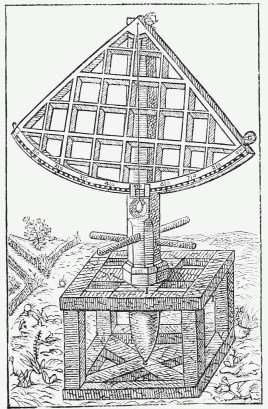
THE GREAT AUGSBURG QUADRANT.

TYCHO'S "NEW SCHEME OF THE TERRESTRIAL SYSTEM," 1577.




